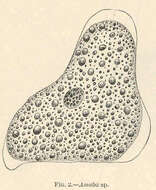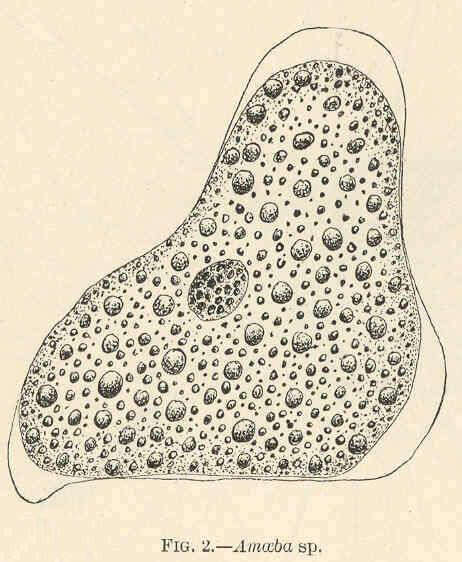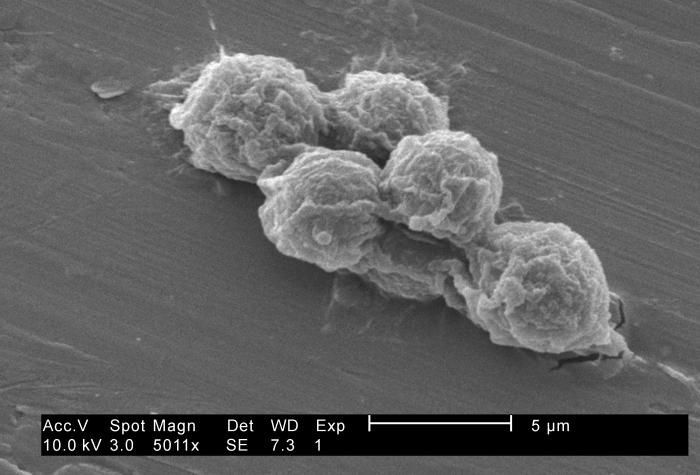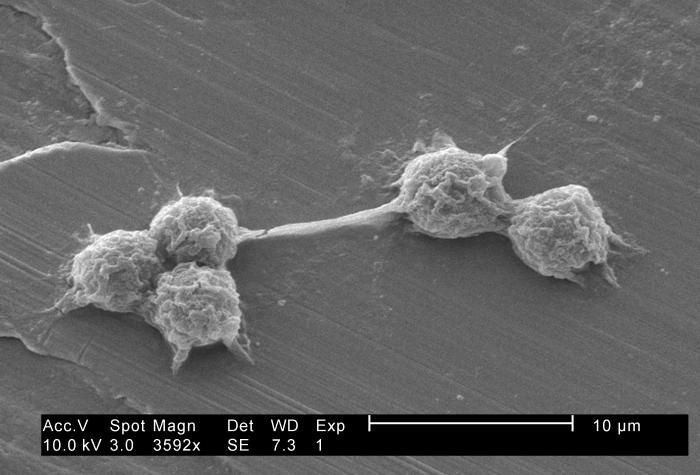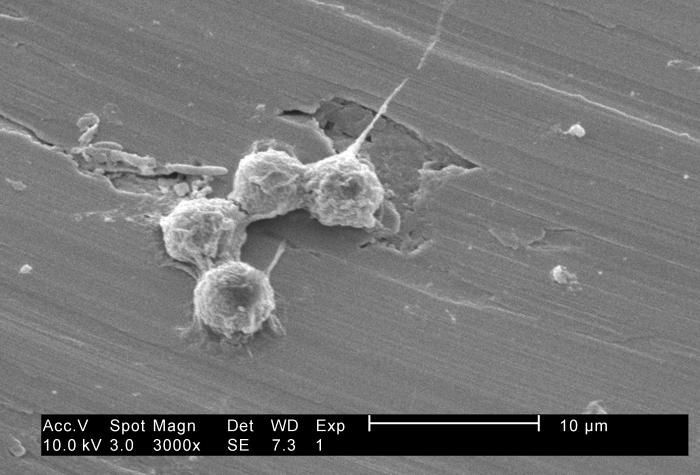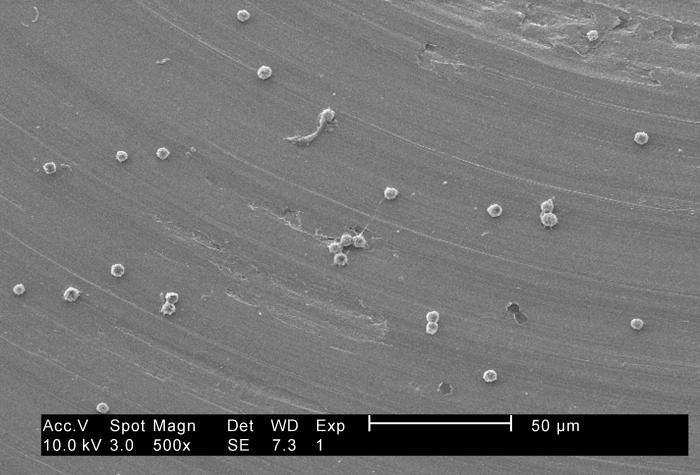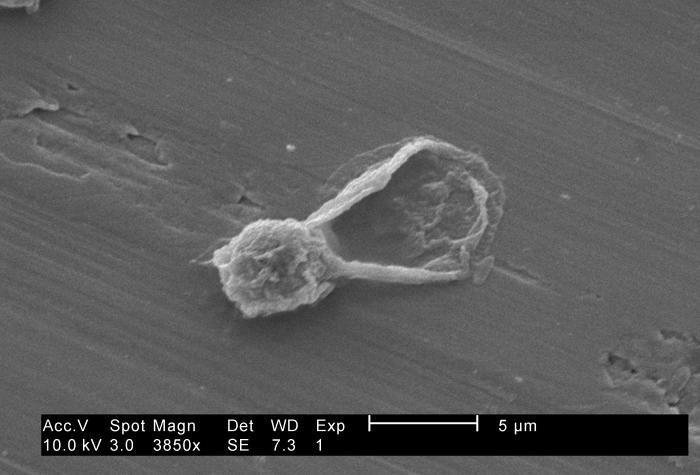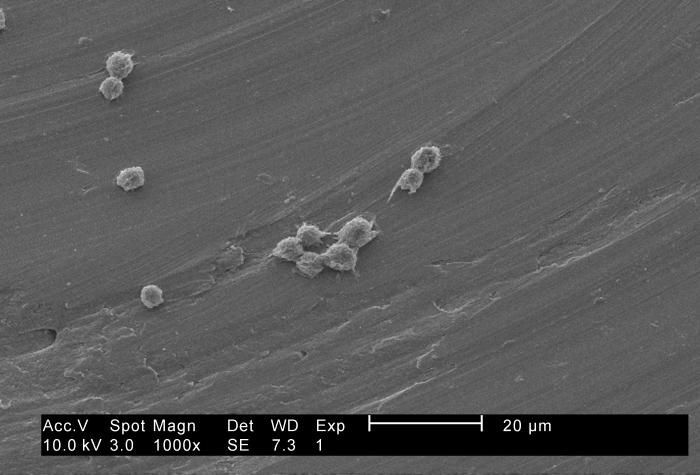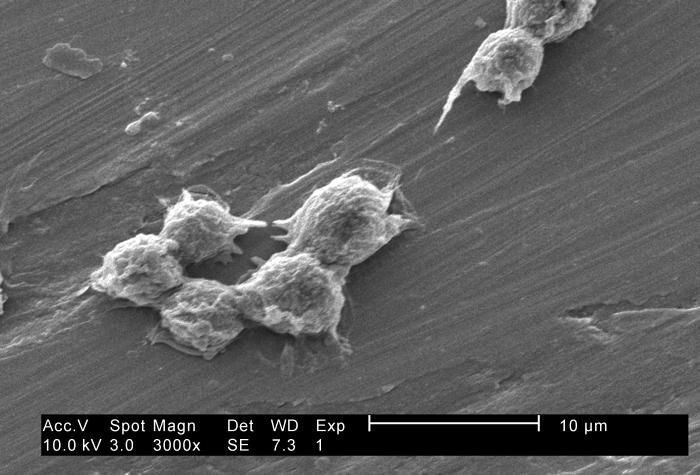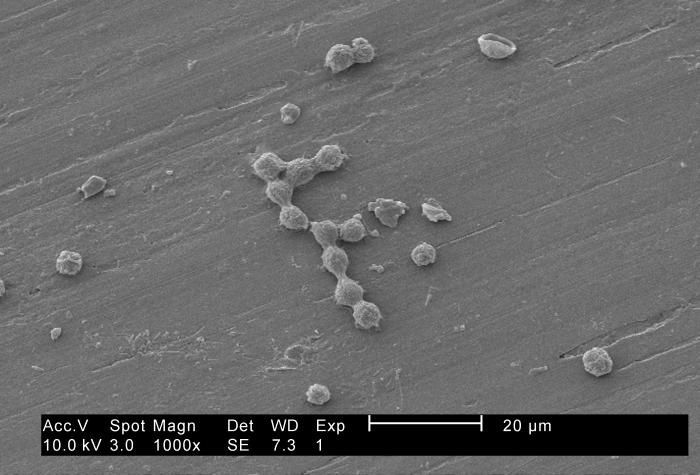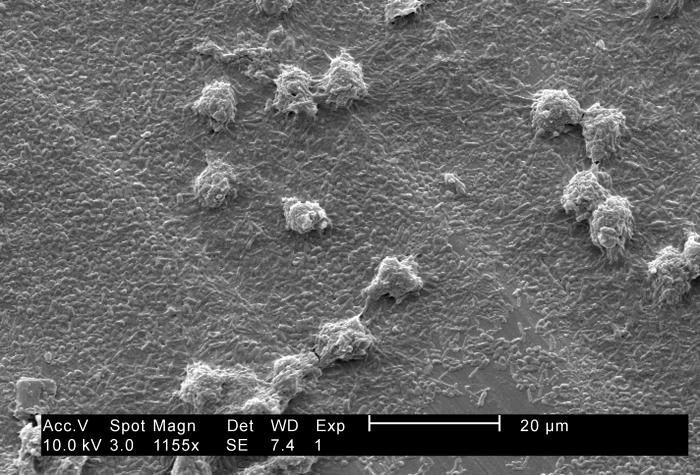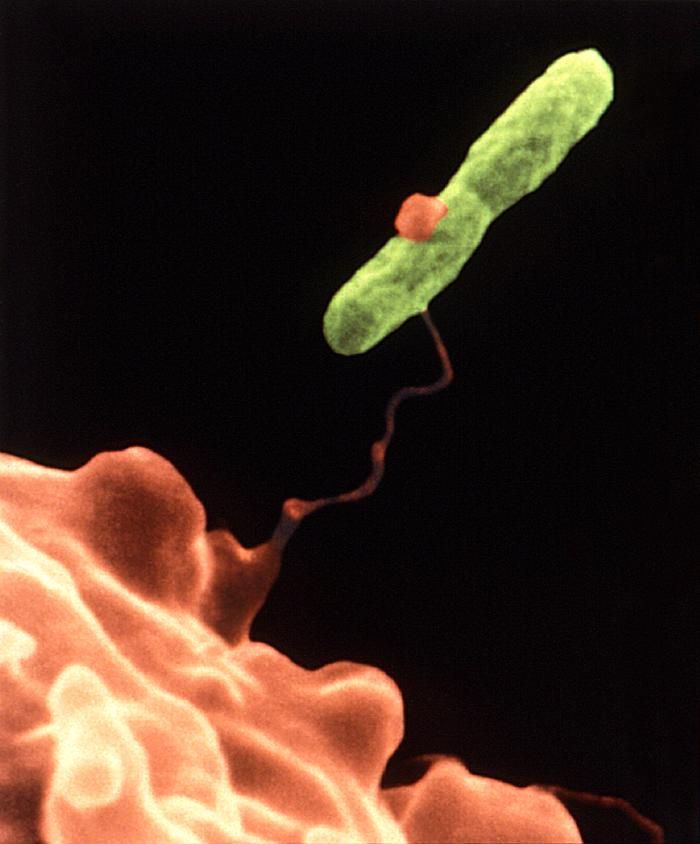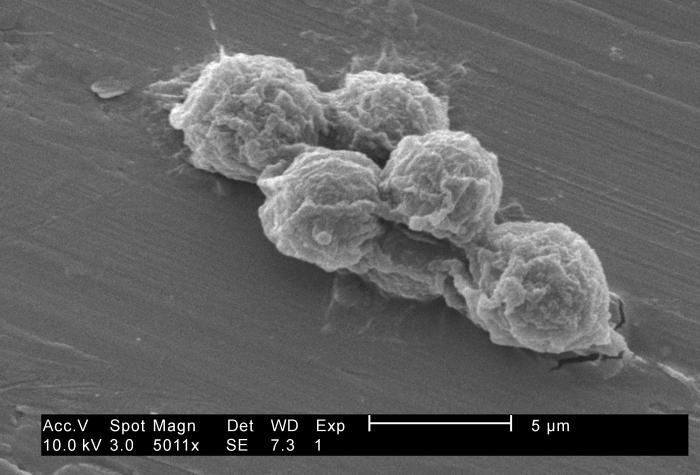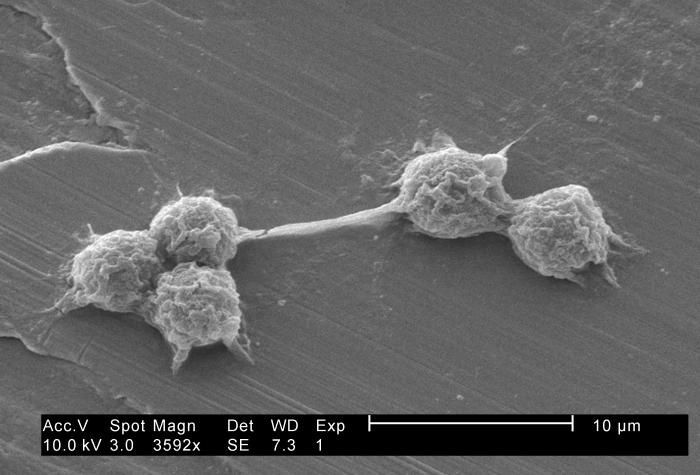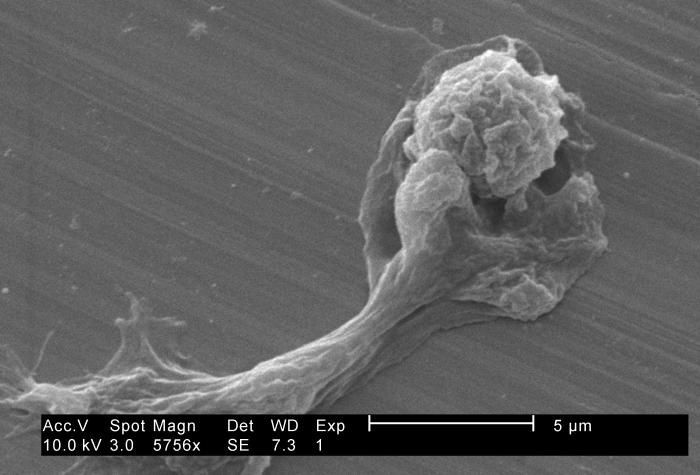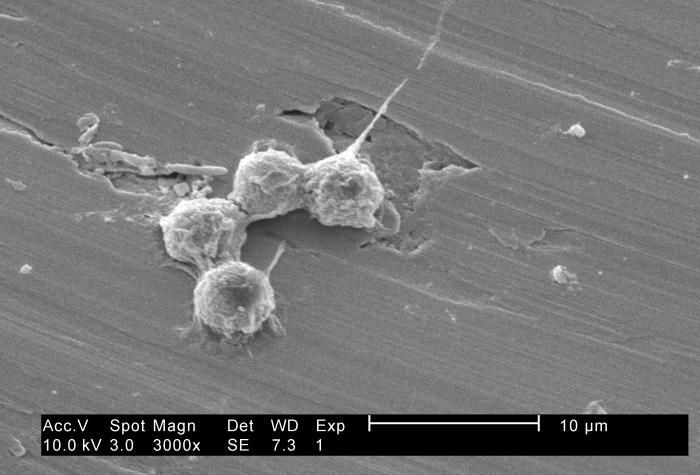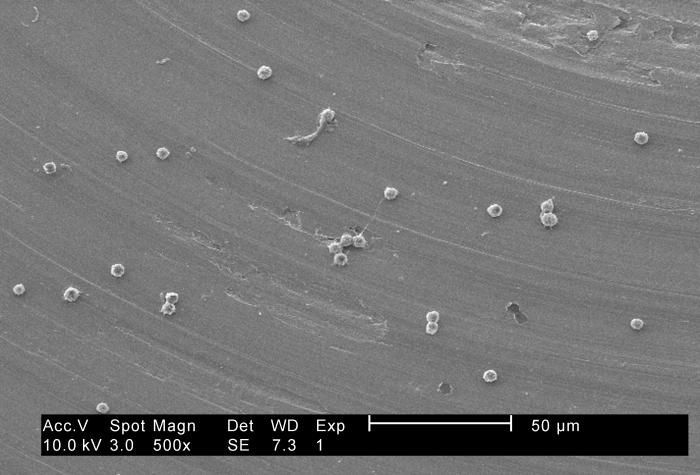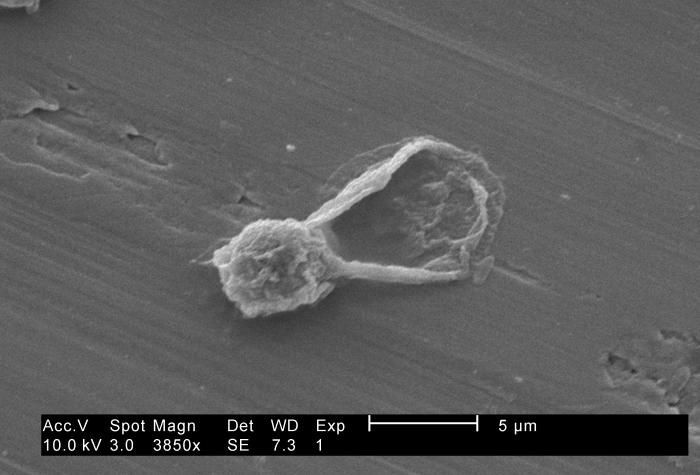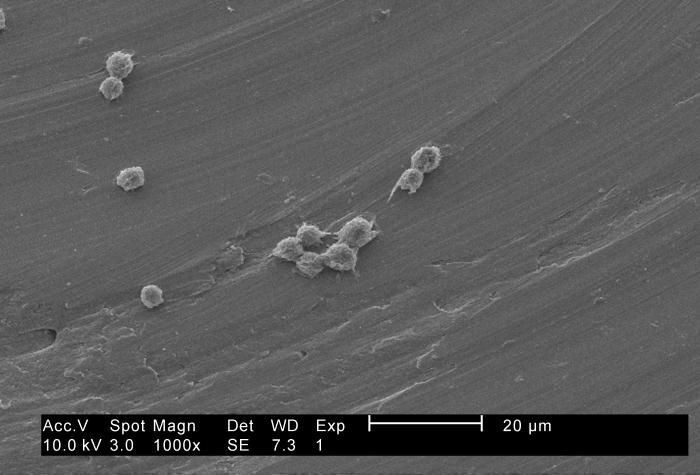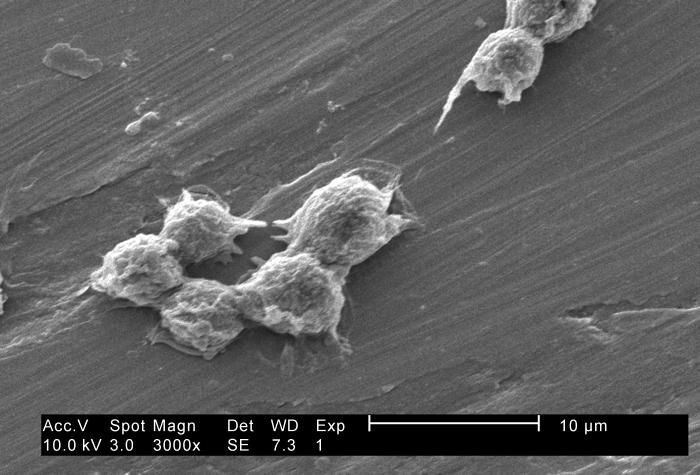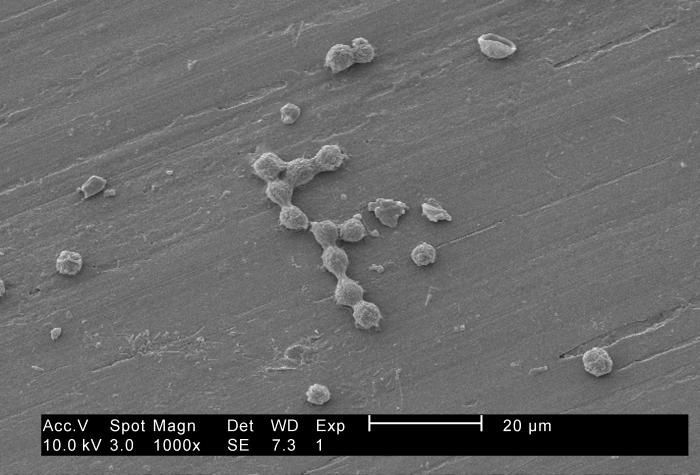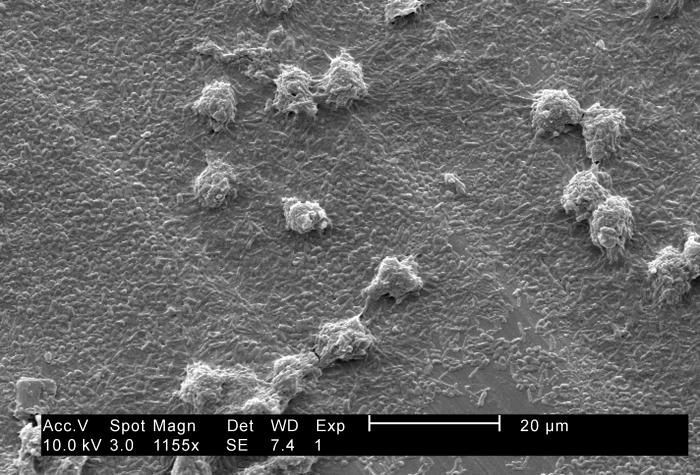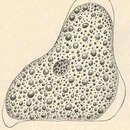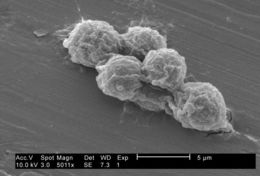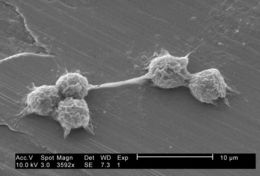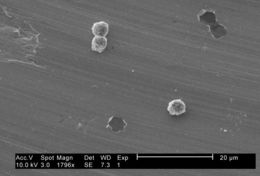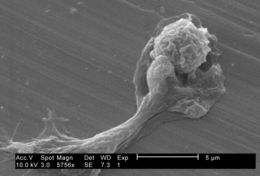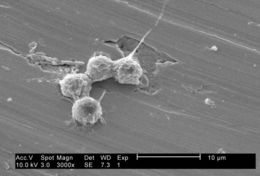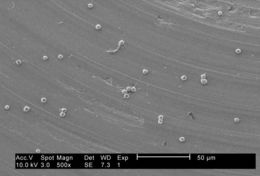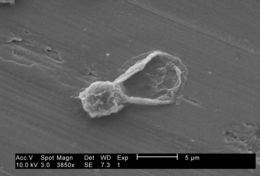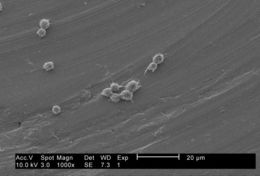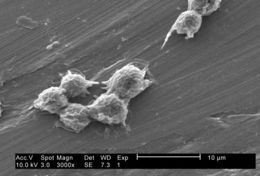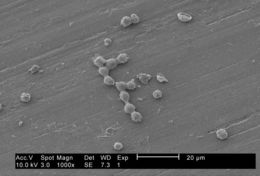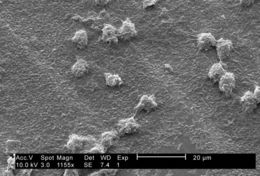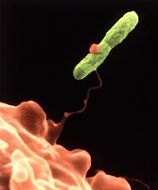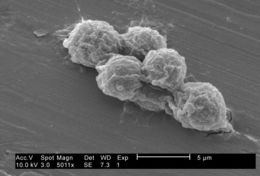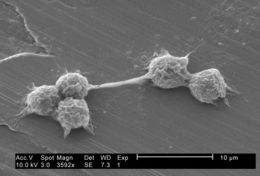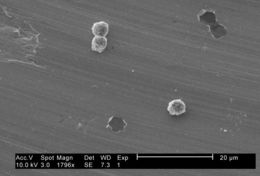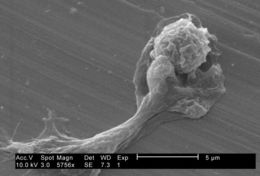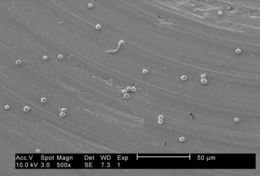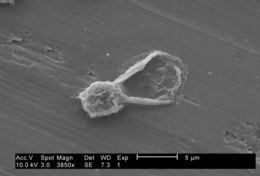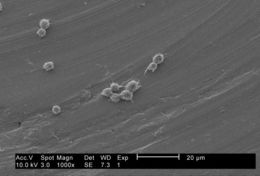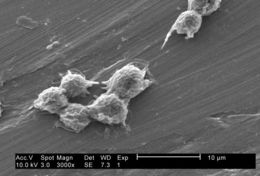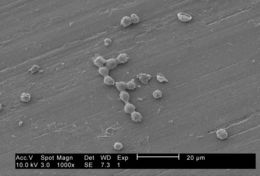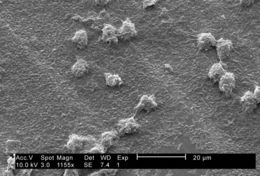-
Amoeba sp..
-
Under a moderately-high magnification of 5011X, this 2002 scanning electron micrograph (SEM) revealed some of the ultrastructural morphology exhibited by small grouping of Hartmannella vermiformis amoebae trophozoites.Created: 2002
-
Under a moderately-high magnification of 3592X, this 2002 scanning electron micrograph (SEM) revealed some of the ultrastructural morphology exhibited by five Hartmannella vermiformis amoebae trophozoites.Created: 2002
-
Under a moderate magnification of 1796X, this 2002 scanning electron micrograph (SEM) revealed some of the ultrastructural morphology exhibited by three Hartmannella vermiformis amoebae cysts.Created: 2002
-
Under a moderately-high magnification of 5756X, this 2002 scanning electron micrograph (SEM) revealed some of the ultrastructural morphology exhibited by two Hartmannella vermiformis amoebae trophozoites. Note that one of the amoebae has assumed a highly distorted shape, having extruded a number of pseudopodia, as it moved across the coupon surface.Created: 2002
-
Under a moderately-high magnification of 3000X, this 2002 scanning electron micrograph (SEM) revealed some of the ultrastructural morphology exhibited by four Hartmannella vermiformis amoebae cysts.Created: 2002
-
Under a low magnification of 500X, this 2002 scanning electron micrograph (SEM) revealed some of the ultrastructural morphology exhibited by a number of Hartmannella vermiformis amoebae trophozoites.Created: 2002
-
Under a high magnification of 3850X, this 2002 scanning electron micrograph (SEM) revealed some of the ultrastructural morphology exhibited by what is thought to be a single Hartmannella vermiformis amoeba cyst, and a debris artifact.Created: 2002
-
Under a moderately-high magnification of 1000X, this 2002 scanning electron micrograph (SEM) revealed some of the ultrastructural morphology exhibited by a number of Hartmannella vermiformis amoebae trophozoites.Created: 2002
-
Under a moderately-high magnification of 3000X, this 2002 scanning electron micrograph (SEM) revealed some of the ultrastructural morphology exhibited by a number of Hartmannella vermiformis amoebae cysts.Created: 2002
-
Under a moderately-high magnification of 1000X, this 2002 scanning electron micrograph (SEM) revealed some of the ultrastructural morphology exhibited by a number of Hartmannella vermiformis amoebae cysts.As part of a study to determine whether Legionella pneumophila bacteria can colonize and grow in biofilms both with, and without the presence of H. vermiformis, here these protozoa were situated on the surface of a stainless steel coupon. See PHIL 11165, which depicted numbers of these amoebae atop a base biofilm, within which Pseudomonas aeruginosa, Klebsiella pneumoniae and a Flavobacterium sp. bacteria had been suspended. By preying upon these bacteria, these amoebae had scoured the stainless steel coupon, thereby, exposing its surface.Created: 2002
-
Under a moderately-high magnification of 1155X, this 2002 scanning electron micrograph (SEM) revealed some of the ultrastructural morphology exhibited by a number of Hartmannella vermiformis amoebae trophozoites.As part of a study to determine whether Legionella pneumophila bacteria can colonize and grow in biofilms with or without the presence of H. vermiformis, here these protozoa were situated atop a base biofilm composed of Pseudomonas aeruginosa, Klebsiella pneumoniae and a Flavobacterium sp. bacteria. Note that the amoebae were grazing upon these bacteria, the end result of which can be seen in PHIL 11166, which reveals the scoured stainless steel coupon surface.Created: 2002
-
This electron micrograph depicts an amoeba, Hartmannella vermiformis (orange) as it entraps a Legionella pneumophila bacterium (green) with an extended pseudopodCreated:
-
Under a moderately-high magnification of 5011X, this 2002 scanning electron micrograph (SEM) revealed some of the ultrastructural morphology exhibited by small grouping of Hartmannella vermiformis amoebae trophozoites.Created: 2002
-
Under a moderately-high magnification of 3592X, this 2002 scanning electron micrograph (SEM) revealed some of the ultrastructural morphology exhibited by five Hartmannella vermiformis amoebae trophozoites.Created: 2002
-
Under a moderate magnification of 1796X, this 2002 scanning electron micrograph (SEM) revealed some of the ultrastructural morphology exhibited by three Hartmannella vermiformis amoebae cysts.Created: 2002
-
Under a moderately-high magnification of 5756X, this 2002 scanning electron micrograph (SEM) revealed some of the ultrastructural morphology exhibited by two Hartmannella vermiformis amoebae trophozoites. Note that one of the amoebae has assumed a highly distorted shape, having extruded a number of pseudopodia, as it moved across the coupon surface.Created: 2002
-
Under a moderately-high magnification of 3000X, this 2002 scanning electron micrograph (SEM) revealed some of the ultrastructural morphology exhibited by four Hartmannella vermiformis amoebae cysts.Created: 2002
-
Under a low magnification of 500X, this 2002 scanning electron micrograph (SEM) revealed some of the ultrastructural morphology exhibited by a number of Hartmannella vermiformis amoebae trophozoites.Created: 2002
-
Under a high magnification of 3850X, this 2002 scanning electron micrograph (SEM) revealed some of the ultrastructural morphology exhibited by what is thought to be a single Hartmannella vermiformis amoeba cyst, and a debris artifact.Created: 2002
-
Under a moderately-high magnification of 1000X, this 2002 scanning electron micrograph (SEM) revealed some of the ultrastructural morphology exhibited by a number of Hartmannella vermiformis amoebae trophozoites.Created: 2002
-
Under a moderately-high magnification of 3000X, this 2002 scanning electron micrograph (SEM) revealed some of the ultrastructural morphology exhibited by a number of Hartmannella vermiformis amoebae cysts.Created: 2002
-
Under a moderately-high magnification of 1000X, this 2002 scanning electron micrograph (SEM) revealed some of the ultrastructural morphology exhibited by a number of Hartmannella vermiformis amoebae cysts.As part of a study to determine whether Legionella pneumophila bacteria can colonize and grow in biofilms both with, and without the presence of H. vermiformis, here these protozoa were situated on the surface of a stainless steel coupon. See PHIL 11165, which depicted numbers of these amoebae atop a base biofilm, within which Pseudomonas aeruginosa, Klebsiella pneumoniae and a Flavobacterium sp. bacteria had been suspended. By preying upon these bacteria, these amoebae had scoured the stainless steel coupon, thereby, exposing its surface.Created: 2002
-
Under a moderately-high magnification of 1155X, this 2002 scanning electron micrograph (SEM) revealed some of the ultrastructural morphology exhibited by a number of Hartmannella vermiformis amoebae trophozoites.As part of a study to determine whether Legionella pneumophila bacteria can colonize and grow in biofilms with or without the presence of H. vermiformis, here these protozoa were situated atop a base biofilm composed of Pseudomonas aeruginosa, Klebsiella pneumoniae and a Flavobacterium sp. bacteria. Note that the amoebae were grazing upon these bacteria, the end result of which can be seen in PHIL 11166, which reveals the scoured stainless steel coupon surface.Created: 2002

